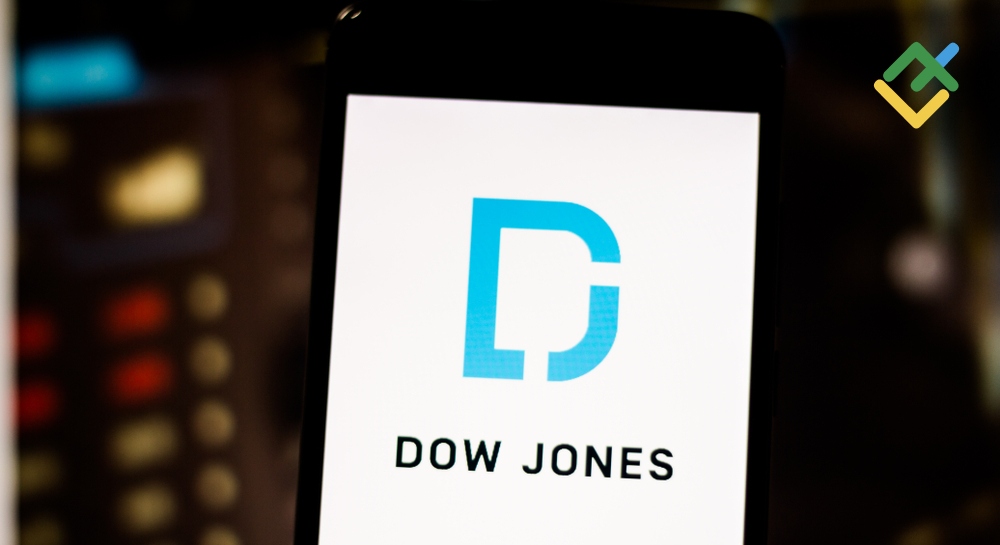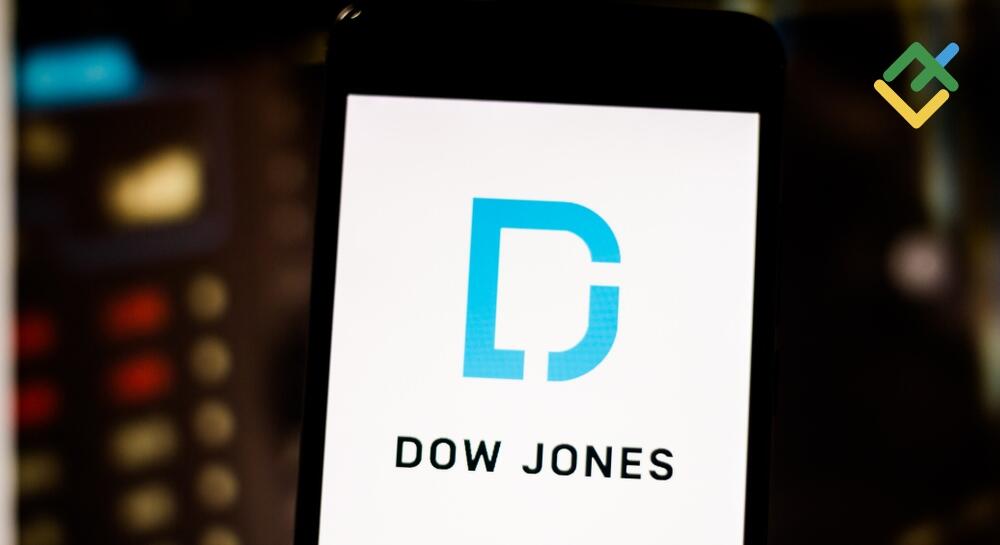
The Dow Jones Industrial Average (DJIA) index is a crucial indicator of the US economy and the global stock market. Evaluating and forecasting its performance is essential for investors, traders, and analysts, as it showcases the state of major US companies and influences strategic decisions.
This article provides a detailed analysis of current trends, a technical forecast for 2025, and a long-term trading plan. It emphasizes the fundamental and technical factors influencing the index rate, enabling traders to make informed predictions and create effective strategies.
The article covers the following subjects:
Major Takeaways
- The current price of YM stands at $44 074.4 as of 22.01.2025.
- The highest YM price of $45067.3 was reached on 2024-11-29, while the all-time low of $40.56 was set on 1932-07-08.
- The DJIA value is influenced by US macroeconomic policies, including interest rate changes and tax reforms, as well as the condition of global markets.
- Sector diversification helps mitigate the effects of crises in specific industries of the economy, ensuring the Dow Jones exchange rate remains relatively stable.
- The DJIA is a key indicator of economic health, reflecting the corporate reports of the 30 largest US companies.
- Long-term projections for 2030 range from an optimistic $68,000 to conservative estimates of $55,000–$58,000.
DJIA Real-Time Market Status
DJIA is trading at $44 074.4 as of 22.01.2025.
It is critical to track key indicators to analyze the DJIA index. Monitoring trading volume over 24 hours helps to assess market activity. Meanwhile, the average volume for three months allows you to assess long-term trends. Additionally, observing the change over a year reflects the exchange rate movement.
| Indicator | Value |
| Trading volume over 24 hours | 543,817,886 |
| All-time high | $45067.3 |
| Price change over the last 12 months | +11.18% |
| Day’s range | $43,312.55–$43,653.25 |
| Number of companies in the index | 30 |
DJIA Price Forecast for 2025 Based on Technical Analysis
Let’s use popular indicators and analyze the key support and resistance levels to conduct a technical analysis of the DJIA index.
Since 2020, the price has been moving within the ascending channel, with support and resistance lines defining its boundaries.
The price is trading below the EMA of 42,843 and SMA of 43,311, which indicates a weakening of the uptrend and a possible correction.
The ascending channel is still in place. However, the asset is approaching the support line, likely aiming to test it.
The MACD line of 893 is below the signal line of 988, indicating a bearish signal. This confirms that bullish momentum is fading, and the correction may continue.
A negative histogram points to increased bearish pressure.
The RSI value is around 49 in the neutral zone. However, the downward price movement may push the indicator reading to the oversold zone below 30, suggesting a possible short-term trend reversal.
The situation signals the weakness of buyers. If the price breaks through the support line of the ascending channel, the uptrend may reverse. In the coming months, the support of 41,000 and the resistance of 43,300 remain the key levels to watch.
| Month | Minimum, $ | Maximum, $ |
| February 2025 | 41,388 | 43,070 |
| March 2025 | 42,190 | 43,910 |
| April 2025 | 42,990 | 44,740 |
| May 2025 | 41,000 | 42,740 |
| June 2025 | 41,9 | 43,650 |
| July 2025 | 42,300 | 44,060 |
| August 2025 | 44,000 | 45,820 |
| September 2025 | 44,700 | 46,540 |
| October 2025 | 45,400 | 47,330 |
| November 2025 | 44,900 | 46,750 |
| December 2025 | 48,000 | 50,000 |
| January 2026 | 45,700 | 47,500 |
Long-Term Trading Plan for DJIA for 2025
The main long-term plan suggests using the ascending channel as a framework for trading decisions. The key entry points are located close to the support line, near $38,000–$40,000.
- Consider long trades on a pullback at the support of $38,000–$40,000 with the target near $43,000–$44,000.
- A stop-loss order should be placed below $37,500 to limit losses.
- If the price pierces the resistance of $47,000–$48,000 during the pullback, one may add to their long positions, aiming for $50,000–$51,000.
- If the quotes fall below the support line, consider short trades with a target of $35,000.
The RSI values in the oversold zone and the MACD lines crossover serve as confirming signals for trades. It is essential to consider macroeconomic events affecting the index to adjust the strategy timely.
Analysts’ DJIA Price Projections for 2025
In 2025, experts anticipate moderate growth in the Dow Jones index, driven by macroeconomic stability and strengthening corporate earnings.
Traders Union
Price range: $41,070.34–$50,005.63 (as of 11.01.2025).
According to Traders Union, the DJIA index is projected to gradually recover throughout 2025, with the lowest price at $41,070.34 and the highest one at $50,005.63. This growth is driven by optimistic expectations regarding the US economy, especially as inflationary pressures ease and the industrial sector recovers. A significant price jump is anticipated toward the end of the year, fueled by positive corporate earnings reports.
| Month | Minimum, $ | Maximum, $ | Average, $ |
| February | 41,384.68 | 43,073.86 | 42,229.27 |
| March | 42,192.35 | 43,914.49 | 43,053.42 |
| April | 42,993.72 | 44,748.56 | 43,871.14 |
| May | 41,070.34 | 42,746.68 | 41,908.51 |
| June | 41,942.27 | 43,654.19 | 42,798.23 |
| July | 42,337.79 | 44,065.87 | 43,201.83 |
| August | 44,029.89 | 45,827.03 | 44,928.46 |
| September | 44,722.15 | 46,547.55 | 45,634.85 |
| October | 45,476.07 | 47,332.23 | 46,404.15 |
| November | 44,921.93 | 46,755.47 | 45,838.7 |
| December | 48,044.63 | 50,005.63 | 49,025.13 |
Long Forecast
Price range: $35,409–$50,104 (as of 11.01.2025).
Long Forecast predicts the DJIA will experience significant volatility in 2025, opening at $42,544 and closing at $46,826. A 10.5% drop is expected in March, followed by a recovery of 10.1% by December. The price is influenced by interest rate changes, fluctuations in demand for equities, and geopolitical factors. The DJIA is expected to start strengthening in July due to the improving macroeconomic environment.
| Month | Open, $ | Min–Max, $ | Close, $ |
| January | 42,544 | 37,753–44,393 | 41,056 |
| February | 41,056 | 36,838–44,462 | 40,192 |
| March | 40,192 | 35,409–40,739 | 38,074 |
| April | 38,074 | 37,816–43,508 | 40,662 |
| May | 40,662 | 37,722–43,400 | 40,561 |
| June | 40,561 | 38,261–44,021 | 41,141 |
| July | 41,141 | 39,868–45,870 | 42,869 |
| August | 42,869 | 41,106–47,294 | 44,200 |
| September | 44,200 | 41,955–48,271 | 45,113 |
| October | 45,113 | 42,396–48,778 | 45,587 |
| November | 45,587 | 42,916–49,376 | 46,146 |
| December | 46,146 | 43,548–50,104 | 46,826 |
Coin Price Forecast
Price range: $44,095–$46,975 (as of 11.01.2025).
Coin Price Forecast predicts an increase in the DJIA exchange rate, expected to reach $44,095 mid-year and $46,975 by the end of 2025, spurred by rising corporate earnings and stable financial markets.
| Year | Mid-Year, $ | Year-End, $ |
| 2025 | 44,095 | 46,975 |
Analysts’ DJIA Price Projections for 2026
In 2026, experts predict that the Dow Jones rate will continue to appreciate, supported by economic recovery and positive market sentiment.
Traders Union
Price range: $44,956.59–$44,762.11 (as of 11.01.2025).
Traders Union predicts the DJIA will stabilize, reaching $44,956.59 mid-year and $44,762.11 by year’s end, with the slight dip in December attributed to a natural market correction after significant growth.
| Year | Mid-Year, $ | Year-End, $ |
| 2026 | 44,956.59 | 44,762.11 |
Long Forecast
Price range: $44,508–$62,565 (as of 11.01.2025).
According to Long Forecast, the DJIA rate will be quite volatile, peaking at $54,208 in March and reaching $56,018 by December. This fluctuation stems from potential changes in monetary policy and corporate earnings. Moreover, experts highlight increased investor activity in summer, which typically boosts the index.
| Month | Open, $ | Min–Max, $ | Close, $ |
| January | 46,826 | 44,508–51,208 | 47,858 |
| February | 47,858 | 46,281–53,249 | 49,765 |
| March | 49,765 | 49,765–58,003 | 54,208 |
| April | 54,208 | 50,501–58,103 | 54,302 |
| May | 54,302 | 50,983–58,657 | 54,820 |
| June | 54,820 | 49,848–57,352 | 53,600 |
| July | 53,600 | 51,620–59,390 | 55,505 |
| August | 55,505 | 53,721–61,809 | 57,765 |
| September | 57,765 | 52,159–60,011 | 56,085 |
| October | 56,085 | 53,378–61,414 | 57,396 |
| November | 57,396 | 54,379–62,565 | 58,472 |
| December | 58,472 | 52,097–59,939 | 56,018 |
Coin Price Forecast
Price range: $49,648–$52,247 (as of 11.01.2025).
Coin Price Forecast suggests a significant increase in the YM price, reaching $49,648 mid-year and $52,247 by December, boosted by strong corporate earnings and investor confidence in the US stock market.
| Year | Mid-Year, $ | Year-End, $ |
| 2026 | 49,648 | 52,247 |
Analysts’ DJIA Price Projections for 2027
In 2027, experts forecast the Dow Jones to strengthen, bolstered by a gradual economic recovery and burgeoning corporate earnings.
Traders Union
Price range: $45,267.07–$47,099.68 (as of 11.01.2025).
Traders Union forecasts substantial gains for the DJIA in 2027. By the end of the year, the index will climb to $47,099.68 due to the improved macroeconomic situation and increased investor activity.
| Year | Mid-Year, $ | Year-End, $ |
| 2027 | 45,267.07 | 47,099.68 |
Long Forecast
Price range: $41,580–$61,649 (as of 11.01.2025).
Long Forecast suggests high volatility in 2027, with prices advancing to $57,616 in early 2027, then plummeting to $47,197 in March. However, the price is expected to rally to $51,372 in December, influenced by changes in monetary policy and foreign trade.
| Month | Open, $ | Min–Max, $ | Close, $ |
| January | 56,018 | 53,583–61,649 | 57,616 |
| February | 57,616 | 51,639–59,413 | 55,526 |
| March | 55,526 | 43,893–55,526 | 47,197 |
| April | 47,197 | 41,580–47,840 | 44,710 |
| May | 44,710 | 44,408–51,093 | 47,750 |
| June | 47,750 | 44,297–50,965 | 47,631 |
| July | 47,631 | 44,930–51,694 | 48,312 |
| August | 48,312 | 46,817–53,865 | 50,341 |
| September | 50,341 | 48,271–55,537 | 51,904 |
| October | 51,904 | 49,268–56,684 | 52,976 |
| November | 52,976 | 47,197–54,301 | 50,749 |
| December | 50,749 | 47,776–54,968 | 51,372 |
Coin Price Forecast
Price range: $53,038–$55,005 (as of 11.01.2025).
Coin Price Forecast predicts a surge in the DJIA, with a mid-year price of $53,038 and a spike to $55,005 at the end of the year, driven by positive stock market sentiment and better macroeconomic data.
| Year | Mid-Year, $ | Year-End, $ |
| 2027 | 53,038 | 55,005 |
Analysts’ DJIA Price Projections for 2028
In 2028, the Dow Jones Industrial Average (DJIA) index will continue to strengthen. However, experts’ estimates regarding the growth rate are divided.
Traders Union
Price range: $48,686.71–$52,056.3 (as of 11.01.2025).
Traders Union assumes that the YM rate will soar to $48,686.71 by mid-year and $52,056.3 by December, buoyed by the strengthening of major companies and optimistic market sentiment.
| Year | Mid-Year, $ | Year-End, $ |
| 2028 | 48,686.71 | 52,056.3 |
Long Forecast
Price range: $48,480–$65,781 (as of 11.01.2025).
Long Forecast predicts the price will rise to $60,346 from January to April, then slump to $57,639 by June. Recovery is anticipated in autumn, with December ending at $61,478. Economic reforms and corporate reports are the key drivers of this volatility.
| Month | Open, $ | Min–Max, $ | Close, $ |
| January | 51,372 | 48,480–55,778 | 52,129 |
| February | 52,129 | 49,548–57,006 | 53,277 |
| March | 53,277 | 51,522–59,278 | 55,400 |
| April | 55,400 | 55,400–64,570 | 60,346 |
| May | 60,346 | 55,732–64,122 | 59,927 |
| June | 59,927 | 53,604–61,674 | 57,639 |
| July | 57,639 | 52,411–60,301 | 56,356 |
| August | 56,356 | 54,274–62,444 | 58,359 |
| September | 58,359 | 56,484–64986 | 60,735 |
| October | 60,735 | 54,841–63,097 | 58,969 |
| November | 58,969 | 56,123–64,571 | 60,347 |
| December | 60,347 | 57,175–65,781 | 61,478 |
Coin Price Forecast
Price range: $62,077–$63,470 (as of 11.01.2025).
Coin Price Forecast anticipates substantial growth for the YM rate, projecting it to reach $62,077 mid-year and $63,470 by December, fueled by tech innovations, stronger global demand, and reduced geopolitical tensions.
| Year | Mid-Year, $ | Year-End, $ |
| 2028 | 62,077 | 63,470 |
Analysts’ DJIA Price Projections for 2029
The Dow Jones Industrial Average (DJIA) index will face a number of challenges in 2029, including changing macroeconomic conditions and geopolitical risks. Nevertheless, experts predict that the uptrend will persist.
Traders Union
Price range: $51,608,49–$50,664,54 (as of 11.01.2025).
According to Traders Union, the rate will reach $51,608.49 by mid-2029 but may drop to $50,664.54 by December. Analysts link these fluctuations to potential changes in the labor market and macroeconomic factors influencing investor preferences.
| Year | Mid-Year, $ | Year-End, $ |
| 2029 | 51,608.49 | 50,664.54 |
Coin Price Forecast
Price range: $64,263–$64,935 (as of 11.01.2025).
Coin Price Forecast estimates that the exchange rate will hit $64,263 mid-year and $64,935 by December, driven by technological innovations and a stronger US market position.
| Year | Mid-Year, $ | Year-End, $ |
| 2029 | 64,263 | 64,935 |
Analysts’ DJIA Price Projections for 2030
According to analysts, the Dow Jones index will maintain its upward trajectory through 2030. Despite possible fluctuations in the global economy, the growth will be supported by financial stability and increasing global demand.
Traders Union
Price range: $53,937.04–$55,875.52 (as of 11.01.2025).
Traders Union forecasts the DJIA index increase, predicting a price of $53,937.04 by mid-year and $55,875.52 by December. Key factors include stable economic development and rising corporate earnings.
| Year | Mid-Year, $ | Year-End, $ |
| 2030 | 53,937.04 | 55,875.52 |
Coin Price Forecast
Price range: $67,698–$68,194 (as of 11.01.2025).
Coin Price Forecast anticipates that the index rate will reach $67,698 by mid-year and $68,194 by the end of 2030, bolstered by the tech sector expansion and a stronger US position in global markets.
| Year | Mid-Year, $ | Year-End, $ |
| 2030 | 67,698 | 68,194 |
Analysts’ DJIA Price Projections until 2050
Analysts forecast significant long-term gains for the Dow Jones. According to Traders Union, the index will continue to rise consistently, reflecting the sustainable development of the global economy and key sectors.
The DJIA is expected to jump to $53,937.04 in 2030, surging to $66,453.97 by 2035 and to $77,270.21 by 2040.
Experts believe that changes in monetary policy, global economic reforms, and geopolitical factors will affect the index trajectory. Nevertheless, long-term forecasts point to the DJIA strengthening thanks to economic diversification and high investment expectations.
| Year | Traders Union, $ |
| 2030 | 53,937.04 |
| 2035 | 66,453.97 |
| 2040 | 77,270.21 |
The projected performance of the DJIA until 2050 shows a steady growth of financial markets buoyed by the development of high-tech sectors. However, remember that such long-term forecasts are approximate, and the actual price will depend on market factors.
Market Sentiment for DJIA (Dow Jones) on Social Media
Comments from analysts and traders on social media directly influence investor sentiment. As for the DJIA index, users’ opinions are mixed.
Analyst John Kicklighter notes that the probability of a bearish breakout is high. This observation bolsters expectations of a price decline.
A trader with the nickname Trader nomad states that the DJIA rate will likely decline with the target at $40,700.
Market sentiment on social media regarding the DJIA is rather bearish at the moment. Analysts predict a decrease in the index values. The general sentiment suggests that investors are cautious and are preparing for possible corrections.
DJIA Price History
The Dow Jones reached the highest price of $45067.3 on 2024-11-29.
The lowest price of the Dow Jones was recorded on 1932-07-08 when the asset declined to $40.56.
The chart below shows the DJIA index performance over the last ten years. It is crucial to evaluate historical data to make the forecasts as accurate as possible.
The Dow Jones Industrial Average (DJIA) index was created in 1896 and has since become one of the key indicators of the US stock market. Over the decades, its fluctuations have reflected the world’s major economic and political events.
Since 1970, the DJIA has posted significant gains despite various crises. In 1987, the index experienced Black Monday, when its rate plummeted by 22.6% in one day.
In the late 1990s, the index surged due to the tech boom, and in 2008, the global financial crisis caused the DJIA to tumble nearly 50%.
The index has rebounded since the 2010s, hitting record highs amid low interest rates and the rise of tech companies.
Today, the DJIA continues to serve as an important indicator of US economic health. The index rate is sensitive to events such as the 2020 pandemic as well as current geopolitical challenges.
DJIA Fundamental Analysis
The fundamental analysis offers valuable insights into the various factors that impact the Dow Jones exchange rate. This section highlights essential elements that influence the index’s value, including economic shifts, changes in financial markets, and developments in global politics. Investors often rely on these indicators to make well-informed decisions.
What Factors Affect the DJIA Price?
- The US federal funds rate affects the cost of capital and lending.
- Macroeconomic indicators, such as GDP, inflation, and unemployment rate.
- Financial reports of the companies that comprise the index. Their earnings determine the changes in the DJIA.
- Political stability and reforms, and foreign economic events.
- Geopolitical events that may lead to short-term fluctuations.
- US dollar exchange rate changes, affecting exports and capital inflows.
- Technological innovation and company development.
- Changes in tax and regulatory policy.
More Facts About DJIA
The Dow Jones Industrial Average (DJIA) is one of the world’s oldest and most famous stock indices, established in 1896 by Charles Dow, the Wall Street Journal’s editor. The index was created to track the stock performance of leading US industrial companies and show the general state of the economy.
Initially, the index included 12 companies, mostly from the industrial sector, including railway, gas, and oil companies. Today, the DJIA includes 30 large publicly traded companies spanning various sectors, from IT and finance to healthcare and consumer staples.
Analysts utilize the index to assess the state of the US stock market and forecast economic trends. Investors often include YM in their portfolios as a risk-hedging instrument.
Advantages and Disadvantages of Investing in DJIA
Let’s review the major advantages and disadvantages of the Dow Jones that can affect trading and investment decisions.
Advantages
- High liquidity. The DJIA index comprises the shares of the largest US companies.
- Reliability. The companies listed in the index boast a solid financial position, and the risks associated with long-term investments are low.
- Diversification. The DJIA covers various sectors of the economy. Issues in one sector will not significantly affect the rate of the index.
- Economic indicator. The DJIA reflects general economic trends, helping investors understand market conditions and prospects.
- Affordability. You can invest in the DJIA through ETFs and index funds. Thus, the costs are minimal.
- Predictability. Historically, the index has been rising in the long run, making it attractive for capital accumulation.
- Resilience to crises. Despite short-term dips, the index usually recovers relatively quickly, which confirms its stability.
Disadvantages
- Limited representation. Only 30 companies are included in the index, which does not always reflect the real situation in the market.
- High volatility. Short-term price fluctuations can be significant, creating a risk for speculative investors.
- Sensitivity to macroeconomics. The DJIA depends on the state of the US economy, including tax and lending policies.
- Absence of small businesses. Only large corporations are included in the index.
- Potential risks. Economic crises and force majeure events may result in significant losses.
- Rare updates to the list of companies. Changes to the index are infrequent, which may weaken its position in the rapidly changing economy.
The DJIA is an attractive instrument for long-term investors due to its reliability, wide range of sectors comprised, and historical stability. However, its limitations require careful analysis. Investors should carefully evaluate their goals and risks before making decisions.
How We Make Forecasts
The DJIA forecasting methodology is based on three time frames: short-, medium-, and long-term, each requiring a specific approach.
Short-term forecasts
Technical indicators such as moving averages and support/resistance levels are used to assess short-term movements. News and events affecting market sentiment are also taken into account.
Medium-term forecasts
Fundamental indicators like company reports, rate changes, and economic data form the basis for forecasting. The analysis focuses on industry trends, their effects on the DJIA companies, and their correlation with the macroeconomic situation.
Long-term forecasts
Long-term forecasts examine historical data and assess the global economic outlook. Structural changes such as technological progress, the transition to a green economy, and trade relations between countries are considered.
This approach provides a comprehensive understanding of the factors shaping the DJIA exchange rate and allows investors to consider short-term swings, medium-term changes, and long-term trends.
Conclusion: Is DJIA a Good Investment?
The DJIA index remains one of the most popular and stable investment options. Its consistent growth over the decades makes it particularly appealing to long-term investors. The index’s stability stems from its diversification, as it includes companies from various industries, which helps mitigate risks.
Investors should be cautious of market volatility and macroeconomic impacts. The index suits those seeking moderate capital growth with minimal risks. In the long term, the DJIA is a reliable tool for forming a stable portfolio but requires regular analysis and monitoring.
DJIA Price Prediction FAQ
The current price of the DJIA is $44 074.4 as of 22.01.2025.
Forecasts suggest moderate growth in the coming years, underpinned by positive expectations of corporate earnings and economic stability. However, the YM rate will depend on macroeconomic and geopolitical factors.
The Dow Jones is projected to gain from 10% to 15% in 2025, depending on economic conditions, financial policies, and the corporate performance of the companies included in the index.
The Dow Jones is predicted to reach the $55,000–$68,000 mark by 2030, bolstered by long-term economic trends and technological innovations in key industries.
The index is calculated as the average stock price of the 30 largest US companies, adjusted by the Dow divisor, which considers splits and changes in the index’s constituents.
Dow Jones is recognized as a reliable asset for long-term investments. The companies listed in the index are steadily developing and represent various sectors of the economy, helping to reduce the risks of potential losses.
Although short-term corrections are possible, long-term forecasts point to a bullish trend due to favorable economic factors.
The current return hinges on market conditions. In 2025, a year-to-date return may range from 5% to 10%, depending on market movements.
The timing of your investments largely hinges on your goals. If you are focused on long-term growth, the current market levels could present a compelling opportunity, especially in light of the anticipated economic recovery and potential corporate earnings increase.
Price chart of YM in real time mode
The content of this article reflects the author’s opinion and does not necessarily reflect the official position of LiteFinance. The material published on this page is provided for informational purposes only and should not be considered as the provision of investment advice for the purposes of Directive 2004/39/EC.
{{value}} ( {{count}} {{title}} )
This post is originally published on LITEFINANCE.










